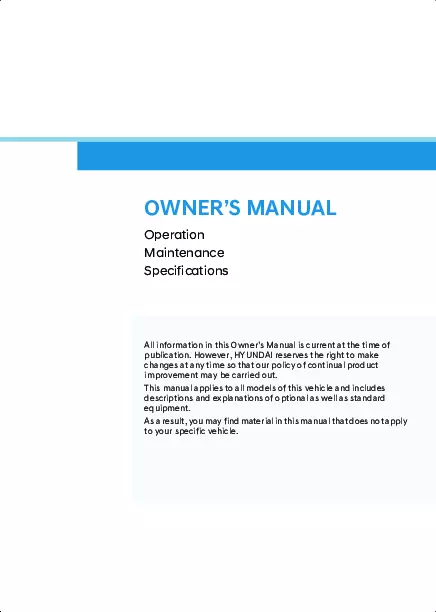2025 Hyundai Tucson Hybrid Owner's Manual

Table of Contents
2025 Hyundai Tucson Hybrid Overview
Introduction
The 2025 Hyundai Tucson Hybrid is a compelling blend of style, efficiency, and advanced technology, making it an attractive option in the competitive compact SUV market. With a bold exterior design that includes sleek lines and a distinctive front grille, the Tucson Hybrid not only looks good but also offers an eco-friendly driving experience thanks to its hybrid powertrain. Perfect for both city commuting and weekend adventures, this model redefines versatility.
Powertrains
The Tucson Hybrid is powered by a cutting-edge 1.6-liter turbocharged four-cylinder engine paired with an electric motor and a six-speed automatic transmission. This combination produces a robust 227 horsepower while delivering impressive fuel efficiency, estimated at up to 38 mpg combined. The innovative hybrid system intelligently manages power between the gasoline and electric components, ensuring a smooth and responsive driving experience, whether you're navigating urban streets or hitting the open highway.
Trims
Hyundai offers multiple trim levels for the 2025 Tucson Hybrid, allowing owners to select the version that best fits their needs and lifestyle. The lineup includes the base Blue trim, which comes well-equipped with a host of features, up to the premium Limited trim, which adds luxury touches such as leather upholstery, advanced technology, and safety features. Each trim level is designed to elevate your driving experience, offering a perfect mix of comfort and performance.
Features
The Tucson Hybrid is packed with innovative features aimed at enhancing convenience and safety. Standard offerings include a user-friendly infotainment system with a large touchscreen, Apple CarPlay, Android Auto, and a suite of advanced driver-assistance systems like forward collision-avoidance assist, lane keeping assist, and highway driving assist. Additionally, available features such as a panoramic sunroof and an adjustable cargo floor cater to the diverse needs of modern drivers.
Owner's Manual
To ensure a seamless ownership experience, the 2025 Hyundai Tucson Hybrid comes with a comprehensive owner’s manual. This manual provides detailed information on vehicle operation, maintenance schedules, safety features, and warranties. It serves as an invaluable resource, guiding owners through the various functions and capabilities of their Tucson Hybrid, and ensuring that every journey is both enjoyable and safe.
User manual download
The Hyundai Tucson Hybrid owner manual for the 2025 model year is to be found in PDF downloadable format on this page. The owner manual for the model year 2025 is free and in English, but the repair manuals are usually not easy to get and may cost more.
Manual Questions
Fill the form below and someone will help you!
